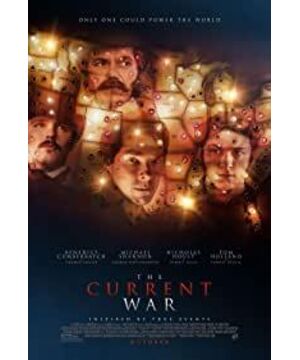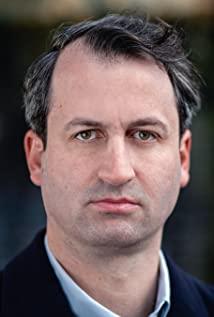The director tries to focus on the tit-for-tat of Edison, Tesla and Westinghouse, using mutual business competition to show their contradictory images of inventors and reckless coexistence, and give the sacrifices behind these great men Lost things, restore the three-dimensional and dark side of the great historical man.
In the film, the director used a lot of camera language to emphasize the antagonistic relationship between the two inventors and the negative impact of this highly antagonistic emotion on the surrounding people, thus showing a certain tragedy of the inventor ——They are no longer pure inventors, and because of this, they lose what they hold dear, whether it is their original intention or their family members.
First, in the first shot, Edison is standing in a white void. This picture corresponds to Westinghouse's assistant's evaluation of him later, "He builds his own real world", and invents everything needed in an empty world from scratch, which is exactly the emphasis on Edison's identity as an inventor. But on the flip side of such an image, Edison's dark side was immediately revealed—the aggressiveness in his conversation with the president, and the subsequent hostile expression of the pigeon-shaming invitation to the Westinghouse dinner. It can be seen that through the two opening paragraphs, Edison's two sides have been shown. So far, the film's expression is very smooth and easy to understand.
However, next, the director seems to have fallen into a kind of excessive abuse of "audio-visual film expression". In his designs, Edison's poor interpersonal and communication skills worsened his attitude toward other inventors. In one of the president's scenes, the director arranged for Edison's son to secretly communicate with Edison using Morse code, and then the wife's funeral also showed Edison and his son comforting each other in Morse code. In addition, Edison's reception of his wife's love can also be completed after his wife's death through a tape recorder. The director used the method of "Edison's communication with people needs to be round the corners" to show the low communication ability. However, for the expression of this point, the director just blindly used the close-up of the fingers that typed the code, and the zooming from blurring to clear when listening to the tape recorder, such lens language, to emphasize the elaboration. In contrast, how Edison showed poor communication skills in his communication with other people was only fragmented by being rude to his subordinates and Tesla.
And for the hostility between Westerhouse and Edison, the director also committed this problem. When Edison received that Westhouse's company was booming, the director gave a flashback of "the train passed by without stopping in front of Westhouse when Edison missed his appointment" to show Edison's rekindling of emotions. On Westhouse's side, when he was rejected and returned home, the director also cut into a flashback to show his memory of being "threatened by guns", and added a close-up of Westhouse's guns to illustrate this. When he felt Edison's hostility, he fought back with a hostile heart. In these two paragraphs, the director used the way of camera expression, but it was very stingy on the plot level. Everything is expressed by the movie audition system, which makes the movie look and feel not smooth. The two flashbacks, due to the lack of synchronous echoes of the plot lines, seem a bit inexplicable and mess up the rhythm. The flashback of Westhouse is even more meaningless on the plot level. There is only one fragment of the momentary memory picture before and after, which is purely designed to express the hostility of Westhouse.
Likewise, when the director tries to express the full intensification of the hostile battle against each other, the language of the shot again occupies most of the expressive space. The director designed a lens language rule of "the camera zooms in on the light bulb on the map to express the spread of war", which is used many times - first, Tesla's arrival in the United States, "Tesla joins the war"; then "Tesla joins the war"; Light bulbs on the map and the camera zooms in," followed by Westhouse's expansion in the U.S. to show the spread of the war across the country. In addition, the director also used slow motion pictures of "telephone poles densely covered with dark clouds in the sky" and "the city's underground power line project in full swing" to express the suppression and amplification of the power confrontation and its spread in the city. However, in the same way, the director once again abandoned the expression of the plot level, and in some places it was even worse - even if Tesla drew pictures on the notebook, it can explain the meaning of his joining the warband, but in the final film we are in that part Don't even know who he is.
A similar situation occurred in the expression of Edison's negative influence. Edison's poor communication skills and hostility to people forced Edison's wife to be assimilated, and she also showed a tendency to be hostile to people - in the scene with the female reporter, when shooting the front and back fights on the side of the two, the director deliberately did not follow the instructions. As usual, the characters are placed on the edge of the back, leaving enough space for the two to face each other, but the opposite is true, which strengthens Edison's wife's accusation of each other. And the pressure caused by this assimilation and Edison also overwhelmed his wife, who fell ill and died. And here, the pressure is still displayed by the camera - a close-up of the needle, rather than any direct expression of the wife's performance. A similar usage of "the camera image emphasizes tit-for-tat" is also applied to "close-up of the face". When the camera is in front of people, it can cause visual oppression and show the mutual hostility between the three inventors. Similar intentions are also reflected in the cutting of the characters' dialogues: the deliberately accelerated forward and reverse shooting and the frequency of panorama cutting mirrors increase a kind of tense taste of needles on Maimang.
In the movie, Edison's attitude towards invention has changed. At first, he opposed killing people with inventions (the invitation to invent arms was rejected), and then because of his hostile competition with his opponents, he accepted "seeking life" - first electrocuting the horse in order to combat the danger of alternating current (similarly pulling the brakes Before writing to Matt), then agreeing to the government's proposal for electrocution and making his invention cause pain. This clue to the attitude towards death with invention is a relatively clear part of the plot level in the film.
But what must be said here is that in this part, the director used the audition language somewhat uncontrollably: first, he deliberately flashed back the pain of the prisoner who died by hanging, and then he used the moving pictures of horses, leopards, orangutans, and people to flatten it. The picture, followed by the newspaper feature of the person in the picture who surrendered and died in the first electrocution, to express the message that "killing an animal (horse) is equal to killing people and giving pain", emphasizing Edison's original intention of distorting for competition—— In order to fight against his opponent, he no longer insisted on not inventing for the sake of killing, but killed the horse, and once he had a beginning, he would immediately go further to "kill". However, in that paragraph, the sudden appearance of the hanging scene was too abrupt and separated from the main storyline, making it difficult for people to understand.
Therefore, in this film, there are too many arrangements in which the language of the audition comes first and the plot is weak. For example, if the director wants to show the black and white duality of the inventor, he uses a large number of oblique perspectives throughout the film to shoot the characters, so as to express the characters. the contradiction. There is no problem with this expression itself, but the problem is: it is used too much, and the performance of the plot level is slightly weak (it is just that the three companies gradually escalate and expand each other, and the three attack each other without knowing the bottom line), the camera itself seems to be It is very profuse and deliberate, but it is pretentious - this is also the biggest problem of this film: the film language is wholesale, but the plot level is difficult to fully correspond to, and the isolated and large number of film language expressions can only become vague. . In quite a few passages, the director could have easily given simpler and more direct expressions - such as expressing his wife's pressure through self-report, expressing Edison's communication difficulties through poor communication, and directly filming Edison's exchange of benefits. Accepting the application of electrocution - but the director insisted on eliminating the plot level and using a bunch of close-up slow-motion and flashback performances, as if to elevate the level of the expression of the work, and "do not speak human words".
But, to its credit, the plot-level issues improve in the second half of the film. The narrative is divided into two stages to advance, showing the different stages of the inventor's change: with the deepening of the war, the hostility of Edison and his friends and businessmen also made them more and more darkened. The electrocution incident and the Westhouse employee casualty incident constitute a stage. The first theme is "death" - Edison's recognition of the application of invention to killing distorted his heart, and he also used "death" to attack the opponent's alternating current career, and the Westinghouse camp caused an electrocution accident due to the pursuit of the Chicago showdown with Edison. spoiled. As another clue, the involvement of business giants with the help of business rules has also changed the world view of inventors: Tesla lost its patent rights due to the commercial contract when preparing the company; Westinghouse was under pressure in the AC business. He was forced to accept the acquisition of a giant company, agreed with the giant's decision to use direct current, and faced defeat against Edison, but although he comforted himself that "I always wanted to cooperate with Edison", he was still unwilling to compete with the failure- --The consistently shaky footage in a self-explaining passage to his wife points to Westinghouse's inner turmoil at this time.
In this section, due to the richness of the expression at the plot level, the richness of the lens language no longer appears to be overflowing, but echoes the meaning of the plot. In Edison's release of the gramophone, the director's technique is a cross-cut between Edison, who released the phonograph that needed to be technically perfected in advance in order to win Chicago, and Tesla, who was competitive when playing billiards----2 People's awareness of struggle has been strengthened again: Tesla has been played by business rules and has fallen but still has a competitive spirit, while Edison's inventor attributes have begun to succumb to commerciality. Such a highly contrasting intersection makes Tesla's preservation of the original heart and Edison's deterioration form a contrast. After Westinghouse was attacked by Edison's alternating current and suppressed his career, the director also used a beautiful panning shot, sweeping the extinguishing of the AC light bulb and the lighting of the DC light bulb, and finally the camera fell on Westinghouse's On the face, it expresses the psychological impact of the loss of competition on Westinghouse extremely efficiently and concisely, and then uses a stretched lens of the giant staff to illustrate the gradual commercialization of Westinghouse under the pressure of competition.
The further deepening of the "pure commercialization struggle" has become the second stage: Edison accepted the Siemens acquisition in order to win, while the other two joined forces to kill Edison with the standard businessman logic of "eternal interests rather than eternal enemies". ——So far, the three people have become businessmen through and through, and they are no longer mere inventors. At the beginning of this stage, Westinghouse could not bear the emotion of losing the competition, and decided to continue the war (at this time, the language part of the camera was matched with another flashback of "threatened by guns"). On the other hand, Edison received a call from the business giant and was told to "still support Westinghouse", and the anxiety of competition began to force Edison to embrace business more deeply, so as to win in the competition (on the lens language, repeatedly to Edison Stretch the camera with investors to show that the "business that dominates the victory and defeat of the competition" is approaching Edison step by step, forcing him to gradually deepen the deterioration). And this progressively deepening competition and the self-transformation it fostered to embrace business led to Edison's decision to "get official support for the manufacture of the electric chair" and use "killing electricity" to attack alternating current (a further extension of the "death" thread: Edison Going further on this road), and eventually led to the opponent's counterattack, and finally the two attacked and defended each other and won and lost on a purely commercial level, through partnership and mergers and acquisitions.
At the same time, although there are still a lot of use of lens expressions in this paragraph (such as the continuation of the character composition method in the first half: oblique composition when shooting people, placing people on the side of the screen instead of the conventional middle, to express people inner struggles and progressive distortions). And, the close-up of "the only AC light bulb surrounded by DC light bulbs on the map of the United States" given by the camera before Westinghouse countered "killing electricity" with commercial standard legal means as "competitive pressure on Westin". The expression of House's influence", as well as the repeated application of the "flashback" of Westinghouse being influenced by competitors, and the "red light of alternating current" as the main illumination light when Edison and the secretary argued about the change of their own principles, are all Key expressions at the lens level. But the content of the plot level has formed a good correspondence with it, making all the expressions accurate and rich.
This echoes the expression of the language of the camera at the level of the plot: the deepening of the hostility and the expansion of the competition between inventors will distort their original intentions, turning them from a simple inventor into an omniscient businessman. As the conclusion of the power war, the director combined the two clues of "killing life" and "commercialization", using the cross-cut of electrocution and alternating current to light up the Expo (especially the synchronous editing of the two putters), to illustrate the Own thoughts: The inventor twisted the original intention of "not inventing to kill", and at the same time became completely commercialized, all for the victory of competition.
In the closing part, the director seems to have injected some hope into the work. Westhouse asked Edison: Think how excited you were when the light bulb that lasted 13 hours was first invented. This sentence expresses the essence of what the director wants to express: the original intention of inventors is just to invent Notebook thinking about the inventions listed), but in the real world, in order to strive for a platform and opportunity for their own inventions to continue, they can only be passively forced by the situation and twisted into a businessman with no lower limit and hostility to his peers. The objective situation in the real world forces inventors to carry out "wars", which makes inventors become complex human nature with strong black and white duality, and profoundly affects their family members so that they lose what they care about and become a family member. The protagonist of the tragedy stage. But here, through this question, Edison and Westhouse, who had failed in the competition, seemed to realize their depravity and reached a reconciliation.
And, this optimism continues into the final scene of the film. With the echoes at the beginning and the end, the director's handling is very subtle. First of all, he left a little hope in the tragedy, let Edison admit defeat after going through everything (the awakening of his own loss of heart), and turned to the film industry to continue inventing, thus returning to a pure inventor. In the first act of the beginning, he is in a white void, as if he is going to fill the whole world with inventions, as the secretary said. This is the original intention of his inventor. At the end, the whiteness disappeared, and he was filming a movie at the waterfall—a new support for inventing pursuit. This end-to-end confrontation allowed Edison to regain his original heart in the field of film. Moreover, such an arrangement of beginnings and ends, just like the handling of lens movements and editing rhythms that are particularly emphasized in the film, makes the film "advanced" at the purely technical level.
However, at the same time, the director placed Tesla in the film -- of course, any film that talks about Edison and "electricity" can't ignore this character. In this film, the director did not "use Tesla for the sake of using it", but used him as a symbol: in the midst of competition and commercialization, he retained the inventor's pure heart of "being obsessed with creation" The presence. Even though he was also taken away by the business rules of his patent rights and company, his competitive spirit still did not lead him to go completely wrong, and he still had a simple way of thinking and acted only on the basis of the facts of scientific truth (in Edison's order for While distorting the facts of alternating current by attacking opponents, Tesla announced his invention to defend Westinghouse, which he had no interest in). As mentioned earlier, Tesla in this film played a negative role in Edison, to highlight Edison's gradual loss.
However, at the end of the work, Tesla's meaning goes even further. He worked with Westinghouse to promote his invention, which seemed to be an optimistic ending. However, in fact, anyone familiar with Tesla's history will know what happened to this genius in his later years. Therefore, when we watch the ending with this historical fact hidden by the film itself, Westinghouse's cooperation with Tesla is just another repetition of the cooperation between Tesla and businessmen in the first half, a commercial Just another use for the inventor. And Tesla's fate, like the ending of the first half, will inevitably fail. Under the director's use of Tesla, the final fate of Edison, who turned to movies and seemed to find himself, seems to have changed from hope to tragedy: pure inventors can only fail in the end, and if they want to compete for victory, they cannot Avoid twisting yourself.
Although the second half of the film has improved, we still can't ignore the film's problems in the long first half: there are too many scenes in the film, and the information at the plot level is too thin, causing the film to fall into a state of ambiguity and pretense of deepness . But this isn't the director's unique problem. In "Copying Beethoven," starring Ed Harris and Diane Kruger, the academy-trained director, while filming the premiere scene of "Beethoven," imposed frequent and almost vomit-tinged "Fast rotation of the camera", "fast editing", "close-up of characters' expressions" and "screeching of the camera" reflect the shocking degree of this symphony masterpiece spanning classical music and romantic music. For a film, the foundation and guiding role of the first half are very important. It states the basic setting of the characters and guides the theme of the work. The first half of the film is too weak due to the plot and the director's influence on the camera. The deep obsession with the technique has seriously shaken the foundation. It's beautifully shot and completely subtle, it's just a show of technique, and making all expressions clear and precise is what a public film should achieve. The role of lens language is by no means "technology for technology's sake", but to improve the efficiency of expression and narration, and to avoid too much plain and straightforward straightforwardness, as done in the second half of the film.
Obviously, how to properly balance the expressive weight of the plot level and the film language level, and how to prevent the film from falling into an atmosphere where the creators entertain themselves and pretend to be reserved are the parts that many directors need to improve urgently. As for this film, the meticulous craftsmanship at the lens language level endows the work with dexterous expression and high-end technology, but the thinness of the narrative in the first half turns the sophistication of these skills into embroidered legs. lost in paleness.
View more about The Current War: Director's Cut reviews











